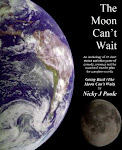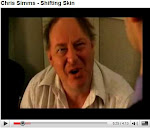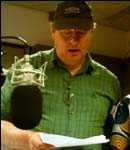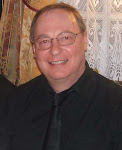
Or something like that.
To some, this would be the end of the story, at least as far as the rainbow is concerned (what the couple get up to afterwards is largely their business though it may require finding a spot of dry ground or a promising weather forecast; we’ll get back to them later.) But the real beauty lies far beyond this. It is in what we can see through the rainbow. I don’t mean the hollow bit in the middle, but actually through the band of colours. Never mind "where does the rainbow end?" Where did it come from?
After all, our couple were walking in white sunlight, and now they are seeing colours, floating in the air. Something very strange is going on here. And very, very important.
It turns out that what is floating in the air is, as hinted, remaining droplets of rain. Each drop of water is taking the white light and reflecting it back. It is also breaking the white light up into different colours. In order to understand how it does this, we have to understand what colour is and what light is.
(As for finding the end of the rainbow – well, you can’t. Firstly, the rainbow doesn’t have an end, it is part of a circle. You can’t normally see this because the ground gets in the way, but you can see a rainbow as a whole circle if you happen to catch sight of one from up in an aircraft. Secondly, the image of the rainbow is formed in the eye from the light reflected by thousands of raindrops and it doesn’t actually have a location – as you move, it moves, so you would never reach a point at which the rainbow hits the ground.)
Firstly, light. In order to understand light, we have to take another step back and look at magnets. Hopefully you’ve seen a magnet and know that they can attract pieces of iron and other magnets. Also, hopefully, you have seen a magnetic rod, left floating or suspended on a bit of thread and been fascinated by the way it always to swing round to point north. This is, of course, known as the North end of the magnet, while the opposite end is the South. There are lines of magnetic force that point out from the North and curve round to the South. This can be demonstrated by putting a sheet of paper over the magnetic rod and sprinkling iron filings on top. The little fragments of iron line up along the lines of force, in what is called a magnetic field. Nothing actually moves from North to South – this was just a convention to show which way the lines are pointing.

A similar force seems present when you rub a piece of plastic on a piece of cloth – something woollen is quite good. A plastic comb run through the hair works the same way. The piece of plastic can now attract little pieces of paper and fluff. This is because the plastic has become charged with electricity. (When experiments like this were first done, they used amber, and the Greek word for amber is elektron.) Like magnets, there are two types of electric charge, but instead of being called North and South, they were called Positive and Negative. An electric field was said to point from a positive charge to a negative charge, in an electric field. Again this was just a convention adopted at the time – nothing actually moves.

Figure 3. Two charges’ field of force.
After a while, it was realised that if you moved something that could conduct electricity, such as a wire, through a magnetic field, electricity would start to flow down it. In this case, electric charge does move.
It took no more than a twinkle to realise an electric force could be used to make a magnetic field.
In fact, it was soon realised that an electric field always has a magnetic field at right-angles to it and vice versa, that is, a magnetic field has an electric field at right-angles to it.

Figure 4. Electric current from a wire moving in a magnetic field.
Using this, it is possible to make moving magnets make an electric current (moving electricity) and electric currents to make magnets move, in things now called dynamos and electric motors respectively.
This seems a long way from rainbows, or light generally. But it’s not.
Clearly a magnet has a magnetic field that reaches a long way from the magnet itself (consider the Earth’s magnetic field.) But suppose you move the magnet – does the magnetic field a distance way change instantly? What if the magnetic was rotating, spinning even, what happens to the magnetic field?

Figure 5. A rotating magnet.
The answer is that the field changes, but it takes a little time for the change to arrive. If you set the magnet spinning the field would change and the change would move in a wave out into the distance.

Figure 6. The magnetic field of a rotating magnet.
It would move very, very rapidly and it would be hard (impossible, in fact) to see this with a bit of paper and some iron filings, but it’s happening all the same. And, at the same time – and at right-angles, the electric field would be changing too. So we would have an electromagnetic wave moving through space.
That’s what light is – a wave of electromagnetism.

Figure 7. An electromagnetic wave.
Two things. This wave moves, as I said, moves very, very quickly. At the speed of light, in fact (Duh!) This is 300,000 kilometres per second. (That’s one reason why you wouldn’t see it moving across a small sheet of paper.)
The other thing is that the waves are very, very small. The average length of a wave of light that you can see is 500 billionths of a metre. (Again, you’d be hard pressed to spot that on your bit of paper.)
The reason why I’ve gone into all this detail explaining that light is an electromagnetic wave is because you need to know what happens if you take wave lengths that are longer and shorter than average.
First of all, light at average wavelength looks green. If you increase the wavelength to about 600 billionths, the light looks yellow. Longer still, and it looks orange, then red, with a wavelength of 740 billionths. If you shorten the wavelength to 450, it looks blue.
So the colour of a beam of light depends on its wavelength. Put another way, our eyes recognise different wavelengths of light by interpreting them to the brain as different colours.
But where does the rainbow get all the different wavelengths from? And what is white light?
Well, it’s again something to do with how the eye works when it is given a mixture of different wavelengths. This is the same as mixing two or more colours together. Anyone who has ever tried painting knows you can get a new colour by mixing different coloured paints together. Much the same is true if you mix different lights together, through the results are slightly different. For instance, a mixture of red and green light is seen by the eye as yellow. Inside the eye, tiny cells at the back of the eye in an area called the retina that detect red or green light both fire and the brain interprets this as yellow. Light that actually is yellow, with a wavelength of 580 billionths, causes both types of cell to fire, so the brain gets the yellow message.

Figure 8. Addition of coloured light, as seen by the eye.
In fact, the retina actually has cells that can detect just one of three colours – red, green or blue. But different colours in between cause the some or all the cells to fire off messages so we see all the other colours as well. If all the cells are firing at the same time with just the right mix of red green and blue, we see the light as white! (Ah!)
This still doesn’t explain how the rainbow is made from white light. The reason is because the raindrops can split up the white light with all its wavelengths of different colours.
How does this happen?
Well, first of all, when light hits the surface of a rain drop, its direction is changed. This also happens when light enters water in a pool or a piece of glass. Indeed, you can use a triangular block of glass, known as a prism, and white light to make your own rainbow. This is actually known as a spectrum.
 Figure 9. A prism creating a spectrum from white light.
Figure 9. A prism creating a spectrum from white light.
Why does the light bend? In effect, this is because the light slows down as it hits the more solid water (or glass.) This is like putting on the brakes on one side of a moving car, causing it to twist to that side (similar to, but not exactly the same as, a handbrake turn!) The important thing is, how much does the light bend? This depends on the wavelength. The shorter the wavelength and more blue the light, the more it bends. The more red it is. The less it bends. This causes the single beam of white light to split up, by bending at different amounts, into all the colours that make it up. This is where all the rainbow’s colours come from.
The next thing that happens is that all the different coloured beams reflect off the back of the raindrop and shine back almost the same way the came in.

Figure 10. A raindrop creating a spectrum.
The collective effect of seeing all these is as a band of colours. The reason why this is curved or bowed is that each raindrop at a slightly different place in the air has to reflect light in a slightly different direction for it to come to you, which, if you work it backwards, means that the collection of raindrops making your rainbow have to be lying in a curve, in much the same way as having a collection of mirrors in a clothes shop are in a curve to allow you to see how you look in your new clothes. (It also means that someone stood at a different position from you is not, technically, seeing exactly the same rainbow as you – but don’t worry – you can’t ever see anything exactly the same as somebody else unless you are stood in exactly the same position, which is of course impossible, because the other person is in the way!)

Figure 11. Why a rainbow is (a) bowed and (b) slightly different for everyone who sees it.
There is another way of making a spectrum from white light instead of using a prism, which exploits the fact that light is a wave. However, before we look at this, and its uses, there is something to add about the wavelengths of visible light. Are these the only wavelengths there are?
Of course not. We could have wavelengths longer than red, at 740, or shorter than even violet (a very deep blue), at 380. It just that our eyes cannot see them! Beyond red lies infra-red, then microwave, then all the different wavelengths used by radio – radio waves can be thousands of metres long! Meanwhile, going in the other direction is ultra-violet, used – unwisely – to get a sun-tan and beyond that are x-rays, at ten-billionths of a metre that will go through flesh and are used in hospitals (more about these later.) Beyond that are gamma rays, that occur in radioactivity, with wavelengths as short as a hundred-trillionth of a metre. These are highly dangerous.
The important thing is that the visible spectrum, like you see in a rainbow, is just one very tiny part of the electromagnetic spectrum as a whole. In effect, realising that there were so many colours we can see, we came to realise there were an awful lot more that we can’t.

Figure 12. The whole electromagnetic spectrum.
We also cottoned on to the idea that there were ways in which we could use this "light we can’t see." One of these was radio, with all the applications that has enabled, from transmitting messages and music and television, to a whole new way of looking at the Universe with radio telescopes. At the other end, for example, as already mentioned, x-rays are used to see through living bodies to find out any damage inside, as well as a way of treating tumours. There is also a form of astronomy known as x-ray astronomy (which, ironically can only be done from spacecraft as x-rays will not pass through the atmosphere.) And there’s another use we’ll look at in a moment.
But back to light, and how to split up light into different colours. An alternative to using a spectrum (or a raindrop) is a device called a diffraction grating. This is just a grating – a glass slide covered with something opaque such as black paint – with very finely scored lines in covering to let the light through. If the lines are on the same scale as the wavelength of the light, they make it split up into a rainbow of colours as before.

Figure 13. A diffraction grating creating a spectrum from white light.
(This is proof also that light must be made up of waves – a diffraction grating wouldn’t work otherwise. If light were made up of little particles, for example which had been an alternative theory. Unfortunately, there is also irrefutable proof that light is made up of particles, not waves, which is very weird – but another story altogether. See the article Quantum Mechanics Magic.)
An example of a kind of diffraction grating is a compact disk. Here you don’t have a slide you can see through but a mirrored surface that is covered in tiny lines. This is why you see colours coming off a compact disk that’s reflecting white light. For a really good look at this, sit in a dark room and put a CD under a desk lamp – you should see rainbows on the ceiling!
When we split up light like this – how many colours do we get? Some people, especially English-speakers, talk of seven, while in other countries sometimes five are mentioned. I’ve shown seven in my diagrams. But in fact there are as many colours as you can think of names for, in a continuous smoothly changing collection. So what happens if we ever do have gaps?
Yet again, we have to take a step backwards. This time, we need to think about what happens when certain things are heated up until they glow, possibly, for example, by having an electric current put through them. While it is possible, deliberately, to make something that glows at a number of wavelengths to give white light – in an electric light bulb, for example – most things glow with a characteristic colour. One of the most familiar examples of this is street lighting that uses glowing sodium to make the light, which has a very noticeable orangey-yellow colour. This is what happens with most things are made to glow – mercury vapour lights, also used for street lighting, have a bluish light. Fluorescent strip lights actually have a coating inside the tube which absorbs the light originally created in them and gives off a number of different colours so that they look white. And so on.
Technically, the colour or collection of colours something gives off like this is known as an emission spectrum, for hopefully obvious reasons. What is useful is that everything has a different emission spectrum, like a finger-print. But we can turn things around. What happens when we shine white light through a gas, such as mercury vapour or vaporised sodium? This time, we find that the spectrum we get from the light coming out of the other side has gaps. The colours that a given substance emits when it is made to glow are the very same as the colours that are absorbed when white light is shone through them. This is known, again for obvious reasons, as an absorption spectrum.
The exact reason for this is a little complicated and I won’t go into it here. Let it be enough to say that the very colours that something most likes to emit are also the colours that it most likes to absorb.
This means that, if we shine a light through a gas, make a spectrum from the light (using a prism or a diffraction grating) and spot a pattern of gaps (known as absorption lines) we can tell what the gas is made of. Like a finger-print, the absorption spectrum is a dead give-away and we’ve caught whoever was in the spotlight!

Figure 14. Absorption lines in a spectrum. (Note that the pattern is not regularly spaced nor are the lines all the same thickness. However the pattern is unique for any given chemical.)
This is very useful for working out what stars are made of, without having to go to the tedious bother of flying in a spacecraft to one to find out. Indeed, one chemical element, Helium, was first detected in the Sun by examining its spectrum closely, before the gas was later found on Earth. Its very name comes from a Greek word for ‘Sun.’
Using some similar tricks of the trade, we can quite easily tell how hot and therefore how bright stars actually are. We then compare their true brightness with their apparent brightness – the effect of being so far away makes the star look dimmer – and so work out how far away they are. Along with a few other clues, we can start to work out how the whole Universe is constructed, how big it is and what it is made of. The full story would fill a book, but we’re going to leave it there and look at one other final thing.
I said earlier that a diffraction grating could scatter white, visible light into a spectrum. But what about other electromagnetic radiation? Yes, that can be scattered too. It would be very hard to make a diffraction grating to work for x-rays, because x-rays have such a short wavelength. But we don’t have to – Nature makes its own diffraction gratings in the form of crystals.
A crystal is just a collection of atoms arranged in a very regular pattern – known as a lattice – very close together. However, there are lots of patterns possible and – as you may well have guessed, these depend on what the crystal is made of. Light has too long a wavelength to work out these patterns, but x-rays work a treat. Once we know the structure of a crystal, we can say other things about it, such as what that crystal might be able to do, given the chance. This way of examining crystals is known as x-ray crystallography.

Figure 15. Molecules in a crystal lattice.
Once again, we have for a moment to take a detour into another part of Nature. For generations (a very important word, that) humans have bred plants, animals and themselves. They couldn’t help noticing that characteristics of the parents were often passed on to the children. The question was: "how?" What sort of substance could both pass on the information – known as genetic information, or, simply, a gene – for making offspring as well as make the copies of the information in the first place? It would take a very clever chemical that could first of all make copies of itself from simpler chemicals.
Research suggested several candidates. One group, that is found in the nucleus of the cells of living things, were acids that, because of their location, were known as nucleic acids. One in particular attracted attention. It is made up of surprisingly simple components. Most notable is a sugar called deoxyribose. This may seem like a slightly odd name, but a little explanation might help. There is another sugar, called ribose, which is not unlike another, more familiar sugar, glucose, and is not in itself particularly special. Deoxyribose, is its poorer brother, having one fewer oxygen atoms in it. That’s why its called deoxy-ribose.
This too, is nothing special on its own. However, deoxyribose’s atoms can link together using a another bunch of atoms called a phosphate group, to form a chain. This chain can be any length and, just to jazz things up a bit, it can also grab on to another chemical group called a base. (There are two types of base, known as either a purine or a pyrimidine, but you don’t really need to know that. Again, these are not particularly special. An example of a common purine is caffeine, which you get in coffee.)
It’s when you put all this together that you get something interesting. It is a substance (which you’ve probably guessed if you’ve been paying attention) that’s called deoxyribonucleic acid, or DNA for short.
But nobody knew whether DNA was special or not. At least, not without knowing its structure. DNA could be turned into a crystal by drying it out – all that was needed was a way to find out its structure. That’s where x-ray crystallography came in.
This makes it sound a lot simpler than it actually is to do – it’s like trying to shine a light through a forest and work out where the trees are from the shadows. However, one thing that helps is, as I said earlier, crystals have very regular patterns, so you get patterns in the shadows. Once you know how to interpret the shadows you get the structure of the crystal.
Which is what duly happened. And when people saw the shape of the crystal, they realised it was very special indeed. Because it turns out that you don’t get one chain in a DNA molecule, but two chains twisted around each other. What’s more, in certain ways, in this double chain, the second chain was like a reflection of the first. If you were then to split the two chains apart, each could create another ‘reflection’ chain to team up with. The two new double chains would be exactly the same as the original.

Figure 16. A double chain of DNA. The ‘backbones’ are sugar-phosphate, the ‘links’ are pairs of bases. These can occur in any order and either way round, but each half of the pair can only match with one other half.
(The way these chains are held together is in another article, Magic Water.)
This was rightly recognised as a way of both encoding genetic information and, most importantly, of making copies of it to pass on to children. The way in which the information is encoded, and how it is used, is, sadly, too complicated to go into here. But it was finding out the structure using that part of the rainbow known as x-rays that helped us find out.
So, at last, we can leave our loving couple, their passion raised by the beauty of the rainbow, to go and do what comes naturally and make babies (in, of course, a duly responsible fashion within an enduring, loving relationship.) And the reason we know how they can is because we found more secrets in a rainbow than just the colours, by looking through it and beyond.
That’s the true beauty of a rainbow, if you ask me.

Figure 17. A picture of a real rainbow, in Missouri © Dan Bush (further pictures at http://www.missouriskies.org/rainbow/february_rainbow_2006.html)
THE END
.jpg)






No comments:
Post a Comment